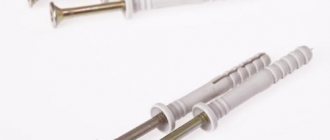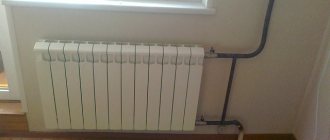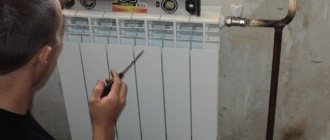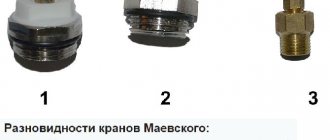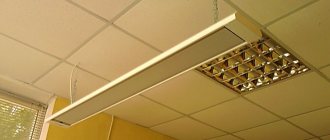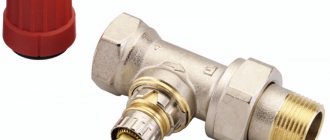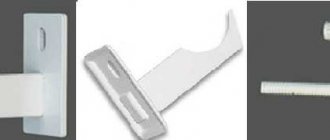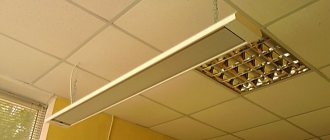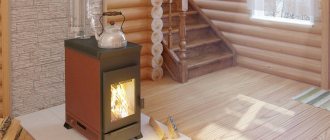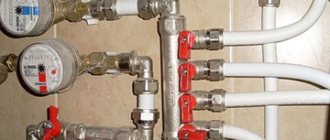A little about heat engineering and radiator grilles
Even if you need radiator grilles for decoration, do not forget that the radiators must heat the room. Any screen reduces heat transfer, even the most delicate and delicate one. Another question is that one will reduce the amount of heat transferred by 10-15%, and the other by 60% or even more. It is unlikely that you will want to sit in a beautiful but cold room, so when choosing a decorative grille you need to take into account how the heat will spread.
The principle of heat transfer from a heating radiator without a grille is shown in the figure. The main idea is that air should come from below, pass along the battery, heat up, and go up. This is how our heating works. When choosing a grille or screen, you need to remember this. For normal air circulation, it is necessary that there is a gap at the bottom and no cover at the top. As a last resort, the lid should have a large perforation area.
Not a bad option - large holes allow air to move freely
But if you look at many of the decorative grilles, you can immediately tell that the room will be cold. This especially affects grilles on heating radiators in the form of a box, which have walls on all sides. If they are very lacy, as in the photo above, there is no particular problem, but if they are made of solid wood (as in the photo below), with almost no or minimal perforations, be prepared for heating inefficiency.
The top of the battery is covered with a solid layer of wood without holes
Wood is, of course, an aesthetic material, but it has a high heat capacity. Until the wood heats up, the room will be cold. And since the array is located above the radiator and there are no holes for circulation, the radiator under such a grille will be hot, but the room will be cold.
Tasks and materials
Most often, grilles are installed on heating radiators for decoration - not all heating devices look attractive, but the grilles are sometimes made very beautiful. The second task that battery screens often perform is to cover sharp and hard edges. This is relevant in families with children, especially if old-style cast iron radiators, the “accordion” type, are installed. Their shape is dangerous, and their appearance is unattractive; they would only be suitable in loft-style rooms.
Grates for heating radiators are made from different materials:
- Metal screens for batteries are produced in large quantities. They are made from thin sheet steel, which is then coated with paint. For the most part, they don't cost much, but they also look average. The service life depends on the quality of the paint. Powder enamels are preferable. They last longer, maintaining their attractiveness for decades. From the point of view of the effect on heating, metal screens for radiators are the best choice. The metal heats up quickly, and then it begins to radiate heat. So the option is inexpensive (usually) and does not greatly affect the temperature in the room (if there is perforation).
The most common form, and the design can be anything
The forging is very beautiful
Wood always looks solid
Openwork decorative grilles for batteries are usually made from MDF and HDF
Plastic washes well, is durable and unpretentious
Screen for glass radiators
Used in the manufacture of decorative grilles for radiators and more exotic materials. For example, bamboo and rattan. Such products are more demanding for interiors and are rare.
Rattan screen on wooden frame
There are also combined grilles. Most often there is a wooden frame on which some kind of decorative mesh is stretched. Bamboo and rattan wickers are most often attached to such a frame. MDF and HDF panels are usually mounted on a wooden frame.
Types and forms
In addition to different materials, radiator grilles come in different designs. All this together creates a huge number of options.
- Flat screens. Most often used if the radiator is installed in a niche. In this case, the flat panel is attached to bars fixed around the perimeter of the niche. In addition, glass screens for batteries also have this shape, but are attached to special pins embedded in the wall. This type of decorative grille for heating radiators is also called “facades”.
Flat screens are installed if the radiator is hidden in a niche
Attached grille-box for radiator
These are only the main types of screens and grilles covering heating radiators. Fantasy is limitless, there are very interesting models, but they are most often made by craftsmen with their own hands.
Homemade screen - an original idea
Price often plays an important role when choosing a screen for a radiator. The range of prices in this segment is more than significant - from 230 rubles for a metal hinged screen, to 8,000 rubles for a glass one. Some prices are shown in the table.
Main function: improve the heating system
When choosing a panel for a radiator, you should take into account not only its decorative qualities. The fundamental criterion here is the ability to maintain a comfortable microclimate in the room
In addition, to avoid force majeure situations, it is necessary to provide the ability to quickly dismantle the screen.
A metal hanging screen fully meets these requirements, and it is very important that its lower edge does not reach the floor slightly. This feature will improve heat transfer and activate air flow circulation
Installing the most suitable metal protective panel will help avoid radiator replacement and cosmetic repairs. It will extend the life of the entire heating system and ultimately help save significant money.
Mounting features
Grilles on heating radiators must be mounted in such a way that you can easily and quickly access heating appliances and pipes. Periodically, at least twice a year, the heating system elements must be cleaned of dirt and dust, so access is necessary. In addition, emergencies arise from time to time. In this case, a quick reaction is required and there is no time to unscrew the fasteners. Therefore, try to come up with a fastening system that allows you to remove the screen in one motion.
Attached and mounted
The easiest way is with mounted or attached screens. They are removed/retracted in seconds. But flat, covering radiators in niches and box screens that are attached to the wall are the most problematic. But even here everything is solved simply. You can secure the box to the wall using two strips: one on the box, the second on the wall. The whole secret is that the top edge of the planks is beveled (you can see it in the picture). The one that is nailed to the wall has a slope towards the wall, the one on the frame has a slope towards the grating. When the box is installed in place, it turns out something like a lock.
How to fix a screen box for a heating radiator on the wall
Another option is to attach metal plates to one of the strips and magnets to the other. Or attach not a wooden plank to the wall, but a metal corner, for example.
In the case of flat screens, the solution may be the same - metal plates and magnets. Another option is hooks and loops. It is easy to implement, but not very convenient to use: while you get into loops, you have to suffer. There is also a difficult-to-install but convenient way: make a screen like a sliding door.
Sliding screens for radiators
You can take the guides that are sold for furniture doors, install them, and insert the screens into the corresponding grooves. If you do not plan to actively use the niche near the battery, you can not install roller mechanisms, but it will be difficult to move them away. This method, by the way, can also be used for the box lattice. It can then be nailed “tightly” to the wall, and the front wall can be made movable.
Basic grating designs
Available options:
- in the form of a box - these are closed screens, they have walls on different sides, which allows you to completely hide the radiator from prying eyes, this option is the most preferable in cases where you need to decorate the shortcomings of the heating device or supply lines;
- flat - such models do not have top and side shelves, they are made in the form of a frame that surrounds a lattice sheet; similar products are installed to cover the batteries located in the niche.
When you need to choose screens for batteries, it is recommended to study the photo before purchasing, since the outside of such products should fit well into the interior. Take into account shade and design
When manufacturing radiator grilles, various possibilities are taken into account:
- The heating system device is installed on a blank wall or under a window opening without a window sill;
- the battery is located under the windowsill.
Mounting features
The radiator grille cannot be installed firmly. The battery, like the entire heating system, must be maintained, and the presence of a stationary screen will make this task difficult. For this reason, such products are designed to be removable. Possible mounting options:
- using magnets: a metal plate is fixed on the wall in accordance with the dimensions of the radiator, and point magnets are fixed on the grille, as a result, the structure can be removed quite easily, and the use of tools is not required;
- locking connection: a plank made of any material is installed on the wall, it must have a bevel towards the vertical surface, and a similar structural element is fixed on the grille, but with a bevel in the opposite direction, which will allow you to fix the screen on the wall without using fasteners;
- sliding structures are installed on furniture rails, which must be hidden by a frame.
Attached and mounted
Both options can be used in different cases:
- the battery is located in a niche;
- The heating system device is installed near a blank wall;
- The radiator is located under the window sill near the window opening.
Attachments are not attached to the wall, so they can be dangerous for children. Such products are distinguished by significant weight and a certain monumentality, which makes them highly specialized. As a result, grilles of this type are often installed in offices, which are designed in a classic style, as well as in living rooms, if they match the interior. To reduce the risk of such screens falling, they are fixed to the floor. The advantage of such products is the ability to be installed at any distance from the battery.
Decorative screens for radiators: how to choose and install
The most modern designs of heating radiators do not fit easily into the interior of a living space, let alone traditional cast iron radiators located in the most prominent places in the room - under the windows.
To disguise radiators, decorative screens are used, made from materials that best suit the style of the interior. In addition to decorative purposes, they are also installed on radiators for safety reasons . In educational and sports institutions, radiators are covered with protective grilles to prevent injuries to students.
Purpose
Decorative screens for the heating system help give your room a more complete look. When carrying out renovations, few people think about how the heating system will fit into the new renovation. Only after the renovation is completed does it become clear that something needs to be done with the heating system.
If you have a new apartment, then the batteries can look quite respectable and fit into the existing design.
But what to do if the house is old and the heating system is old. In this case, you will undoubtedly be helped by screens that can hide your cast-iron radiator, and the heating system will be in harmony with your renovation.
Types of decorative screens for heating radiators
Since, depending on the purpose of installing grilles on radiators, they are made from various materials, manufacturers give consumers the opportunity to choose, offering entire collections of these useful devices that can serve as both an excellent decoration for a residential interior and protection for public spaces.
First of all, screens for radiators are divided according to the features of their designs.
- If it is necessary to close heating radiators located in a niche , then for this purpose they use flat structures, or covers on the radiators, with the help of which the recess where the radiators are located is completely closed.
- If the batteries are placed under a window sill , the area of which is covered by a radiator, then cover plates without a cover are used. They are attached directly to the window sill, hiding the heating devices behind them.
- If the batteries protrude beyond the surface of the window sill , then they will be perfectly disguised by decorative casings equipped with a lid.
If the material for its manufacture is successfully selected, it will not only hide the radiator behind itself, but will also become a wonderful decoration of the interior of the room.
For each type of these products, a variety of materials can be used, which allows you to select the decorative screen that is most suitable for a particular case.
Types of radiators
When selecting components for an autonomous heating system, you need to take into account its features and desired characteristics. Not only the operation, but also the installation of heating radiators in a private home will depend on the selected elements.
Heating systems of private houses differ from centralized ones in the following qualities:
- Firstly, operating conditions are more favorable - for example, the pressure in local heating is an order of magnitude lower;
- Secondly, the quality of the coolant in private homes is always at a higher level;
- Thirdly, there are no significant pressure drops, and the likelihood of water hammer is practically absent.
There are quite a lot of radiators that can withstand such operating conditions, so you will have to spend some time choosing the best option. However, if you simplify the choice of radiators to the limit, then the best option will be products with the best combination of heat transfer, price and quality.
Depending on the design, the following types of batteries are distinguished:
- Panel and sectional. The cheapest type of battery, characterized by fairly high heat transfer and relatively small size. These radiators do not impose any requirements on the connection diagram.
- Tubular. The technical characteristics of tubular radiators are practically the same as the previous type, but the cost is much higher. The increased cost is due to the good visual qualities of tubular products and the ability to use radiators as dryers.
However, much more often radiators are classified according to the material of manufacture, depending on which the following types are distinguished:
- Aluminum. Quite a popular option, perfect for use in private homes. The main advantages of aluminum radiators are good visual qualities and high heat transfer. It takes a little time to warm up, but such radiators cannot retain heat. The cost of aluminum products varies over a fairly wide range depending on the manufacturer and characteristics.
- Bimetallic. This type of radiator, as the name suggests, consists of two materials. Due to this, it is possible to create a product with an optimal combination of characteristics - in particular, bimetallic batteries can withstand pressure drops well and do not corrode. The cost of bimetallic products is quite high, so they are not very popular among owners of private houses.
- Steel. Steel batteries have good heat dissipation and good decorative properties. Simple steel batteries are cheap, but quickly fail due to corrosion. Stainless steel options are more reliable, but also cost an order of magnitude more.
- Cast iron. The arsenal of advantages of such devices includes high wear resistance, due to the high thickness of cast iron and its resistance to corrosion, as well as the ability to operate at high temperatures and pressure changes. Cast iron batteries have high inertia. For normal operation, such products must be cleaned every year.
Materials for making battery grids
Not only its appearance, but also how long it will retain its appearance and how easy it will be to carry out daily care of the product depends on the correctly selected material for the decorative protection element. For many, the cost of such interior decoration is also important.
How to choose a humidifier for a children's room, read on.
Each of the materials used for their manufacture has its own characteristics that affect the quality of the products. Let's talk about the most popular materials most often used to create these decorative structures.
- Metal screens in the economy version look like a thin metal box painted white. Other colors are also available. There are no special frills in their design, which is why the cost of such products is low. The price of a hanging metal protective screen starts from 250 rubles.
The cost of products made from stainless steel is much higher , since they are usually decorated with a pattern made using perforation. This finish gives the product a more elegant look, but it is difficult to fit into the home interior. The main advantage is their ease of installation (they are simply hung on radiators) and low cost.
- Wooden screens are produced in a more diverse range, so choosing a product that harmoniously matches the interior of the room is much easier. In the manufacture of custom-made wooden decorative grilles, valuable types of wood are often used. This is done not only to decorate the interior, but also to minimize the shortcomings of wooden products.
These factors have much less effect on high-quality wood, however, the cost of valuable wood species is higher.
The work of craftsmen who make products from valuable wood is not cheap, and purchasing the material costs a considerable amount.
However, the elegance of the manufactured structures will allow them to decorate the interior of any style, including elements made of wood.
- Screens for batteries made of MDF , used for the manufacture of decorative screens, make it possible to produce products that can compete with natural wood in quality and cost. They are made from this material in any color and shape. In the form of decoration, slotted patterns are most often used, made using programmed machines. The color palette offered by manufacturers can match the color of the interior, or, conversely, differ sharply from it.
- Plastic decorative screens are the most affordable for consumers in terms of their cost. They are available in a variety of colors and sizes, and finished products can be selected for any room. When choosing, you must carefully monitor the quality of the material, since low-quality plastic when exposed to high temperatures is deformed and releases substances that are harmful to health. Therefore, even high-quality plastic is not recommended for use in residential premises and institutions visited by children.
- Glass screens, made from
Photo - Glass screen for batteryDesigners use stained glass or tempered glass to create original, sophisticated interiors. The structure, made of glass, is very fragile, so it should be handled with extreme care. However, the appearance of glass overlays, with exclusive designs applied to them, complements the interior of the room so favorably that they deserve special treatment.
How to make a protective mesh for a grill with your own hands
Ready-made protective nets can be made from materials such as:
- aluminum;
- steel;
- carbon;
- plastic.
Aluminum is a lightweight but durable metal that does an excellent job of protecting the cooling system. Steel meshes are no less effective. Carbon meshes are commonly used to protect the radiators of sports and racing cars, but they are expensive.
The most popular material for making your own mesh is ordinary plastic. It is easy to work with, and its cost allows for some mistakes.
Materials and tools for tuning
To work, you will first need the mesh itself, which can be purchased at almost any hardware store. Chain-link mesh is perfect for these purposes, although other options are also acceptable. The material, be it plastic, aluminum, steel or even carbon, is at your discretion.
Chainlink mesh is well suited as a base
So, to work on the mesh you will need:
- the mesh itself;
- paper;
- ordinary scissors and metal tools;
- metal cutters;
- pencil and marker.
DIY creation
All your further actions depend on the shape of the radiator grille. If it is fairly even, with relatively right angles and clear lines, you just need to measure the length and width of the lattice, and then cut the mesh in accordance with these parameters. However, manufacturing becomes significantly more complicated if the part has a complex shape with a large number of bends or sharp corners.
In order to make a pattern, you will need to do the following:
- Attach a sheet of paper (or glued sheets) to the radiator grille. Press firmly so that you can clearly see its shape, and then trace along the outline.
- Cut out the resulting shape from paper.
- Attach the pattern to the mesh and cut it out. If you are going to install the mesh on the outside of the grate, be sure to leave allowances of about 0.5 cm on all sides.
- Use pliers to remove all excess.
The process of making a protective mesh in the photo
Cut out a pattern from paper that matches the shape and size of the radiator grill Cut the mesh according to the pattern Cut off all excess and your mesh is ready
If the mesh is too fine-mesh and soft, you can use a second mesh with larger cells as a frame. Cut out the desired shape using the same principle, and then connect both parts.
Your mesh is ready. Now all that remains is to paint it and install it on the grill.
The main advantages of decorative grilles for radiators
Screens for radiators not only hide the appearance of radiators, which spoil the appearance of the room, but also give its interior completeness. When changing the interior, replacing decorative structures is easy.
Since it is not easy to care for radiators with a complex configuration, installing decorative casings:
- will facilitate cleaning of premises by protecting heating equipment from dust;
- at the same time they will become a wonderful decoration of the room;
- with their help, warm air from heating devices is more evenly distributed throughout the room;
- they will protect children from bruises and burns that may occur when they come into contact with heating appliances.
The simplicity of their installation allows you to install them yourself. Even in the most difficult cases, you only need to know how to use a drill.
Methods for installing decorative screens for batteries
The method of attaching decorative elements covering heating radiators depends on their design.
For example, mounted options are often designed in such a way that they do not require fastening at all.
They are simply hung on radiators, held on to them thanks to the curved shape of their upper part.
This option is very convenient when cleaning, especially if the product is small in size. It can be easily removed and washed with a stream of water.
If the product is made in the form of a box , then manufacturers provide holes in them for mounting to the wall. The main task in this case is to transfer the location of these holes to the wall, placing them so that the fastening lines are strictly horizontal. To check, you must use a level. Then holes are drilled in the marked places and fasteners are installed, onto which the structure is hung.
Since the range of protective and decorative grilles for batteries is large, each consumer can choose the most suitable option based on his taste, needs and financial capabilities.
The following videos clearly show how to independently assemble and install decorative screens for batteries.
The battery is installed in a niche
One of the most common options for installing a heating device. A niche is a kind of cavity with one open side in which the battery is mounted. You can simply cover it with a screen.
In this case, the decorative panel is installed using visible or hidden fasteners.
Both conventional flat screens and products of a more complex design: with a rear flange and an overhead frame are mounted with visible fasteners. The installation process itself is very simple:
- Countersunk holes are made on the front panel of the screen.
- The product is applied to the niche, pressed tightly and securely fixed using self-tapping screws.
You should not think that by installing a decorative screen in this way, you will get an unaesthetic picture. The screw caps are finished in the same way as the front panel of the product. If you order an accessory made of bright polished brass, then the caps of the mounting elements will have the same texture. A similar rule applies to all screens produced by DecoGrille: made of stainless steel, brass or painted steel.
Flat screens are the most budget option. However, there is one caveat. If the product is wide, it will bend after installation. At the attachment points, the accessory will press tightly against the surface, and in the central part it will slightly retreat from it. To avoid this, the screen needs to be stiffened; the rear flange will do this perfectly.
Rear flange - plates installed on the back side of the front panel at a slight distance from the edges of the frame. A mesh backing and eyelets for hidden fastening are mounted on the flanging sheets.
Back flange screens are more rigid than conventional flat products. After installation, the front panel does not bend; the accessory is pressed tightly against the surface along the entire perimeter.
The process of installing screens using hidden fasteners is more complicated than using visible screws or self-tapping screws. It occurs in several stages:
- Special corners are mounted inside the niche (included with the product).
- The screen is inserted into a niche and is first fastened to the corners through the eyes.
- The product is leveled relative to the surface of a niche or wall and screwed tightly.
The last of the above steps is only possible with hidden fasteners. This is especially true in cases where the niche is curved. After installation, the screen will hide all the mistakes made by the builders.
How to attach the screen to the battery
Just call +7 (499) 39-444-16
1. How to take measurements yourself?
- — If the battery is hanging on the wall.
We measure the length of the battery and add 10 cm to it, add 3 cm to the height and depth. We get the external dimensions of the product. - — If the battery is located in a niche (inside the wall)
Measure the size of the opening and add 10 cm to the length (since the screens are overhead, it is necessary to take into account the distance to the baseboard and window sill)
2. Installation of screens on the battery.
The screens are attached to the wall using 2 self-tapping screws (which are included in the kit). To install the screen, you must have the following tool
: drill, jigsaw, level, pencil and screwdriver. We attach the products to the wall, check the level, mark with a pencil the place for the hole, drill holes with a D6 drill, insert dowels, screw in self-tapping screws, and secure the products. OK it's all over Now.
If the product is not exposed to external factors, it will last for decades.
How to glue? How to calculate the required quantity?
Note! If you are in doubt about the choice and cannot correctly calculate the amount of material required, then we can send our specialist to you with samples and a catalog. Our representative will help
with the choice of material, measurements and calculation of the required quantity of goods!
Just call +7 (499) 39-444-16
You need to glue it like regular wallpaper, but it is advisable to use special glue. We also recommend treating the surface of the wallpaper with protection or varnish.
2. How to calculate the required quantity?
Before you buy wallpaper, you need to understand how much you need. To do this, you need to measure the area of the walls and divide it by the area of the wallpaper roll, round the resulting number up and get the number of rolls.
How to choose a baguette size?
Note! If you are in doubt about the choice and cannot correctly calculate the amount of material required, then we can send our specialist to you with samples and a catalog. Our representative will help
with the choice of material, measurements and calculation of the required quantity of goods!
Just call +7 (499) 39-444-16
The interior baguette is made from a modern material called pressed polyurethane (does not burn, does not burn, environmentally friendly)
1. The entire baguette is 2.5 meters long
This size is easy to transport and leaves little to no residue.
2. The baguette is attached with assembly glue or liquid nails
The joints can be covered with special wax
3. The choice of baguette width depends on the design of your room.
How to choose an arch by size?
Note! If you are in doubt about the choice and cannot correctly calculate the amount of material required, then we can send our specialist to you with samples and a catalog. Our representative will help
with the choice of material, measurements and calculation of the required quantity of goods!
Just call +7 (499) 39-444-16
1. All arches have a full set of connecting elements
2. To select the arch size you need:
— Measure the doorway and compare the resulting dimensions with the maximum dimensions of the arch. — If your dimensions are smaller, then this arch is suitable for you. — If the dimensions exceed the dimensions, then in this case it is necessary to purchase additional elements.
The arches are available for painting and with decoration.
We will help you choose the size!
Note! If you are in doubt about the choice and cannot correctly calculate the amount of material required, then we can send our specialist to you with samples and a catalog. Our representative will help
with the choice of material, measurements and calculation of the required quantity of goods!
Just call +7 (499) 39-444-16
Making a decorative screen with your own hands
The technology for making a plasterboard box is quite simple. If you prepare the material properly, you can give it a marketable appearance that will not differ from that produced on professional equipment.
To make a box you will need the following tools and materials:
- plasterboard sheets;
- metallic profile;
- jigsaw;
- metal mesh or wooden grid (for thermal “windows”);
- PVA emulsion (2 or 3 l);
- self-tapping screws, screws, dowels;
- Decoration Materials.
To increase thermal conductivity in the box, you can use fragments in the form of blinds - this looks aesthetically pleasing and ensures air circulation.
A small number of holes or their incorrect distribution can lead to heat loss (it goes back through the pipes) or the formation of condensation in the upper part.
Step 1: Preparing the Drywall
First you need to measure the battery and cut out the parts. It is necessary to add 7–10 cm to the width, and 3–5 cm to the height. The depth of the upper wall (if any) should be increased by 3–4 cm. It is recommended to roll the cut sheets of drywall with a needle roller from the wrong side. You don't have to buy it, you can rent it.
Then the blanks are impregnated on both sides with PVA emulsion. This procedure must be repeated twice.
Impregnation with emulsion in combination with the work of a needle roller gives the following effect:
- The thermal conductivity of drywall improves.
- The material impregnated with the emulsion does not dry out due to constant heating.
- The paint lays down in a more even layer, no need to putty.
- Cutting the processed material with an electric or manual jigsaw is more even, without chips.
Aerobatics is to make a sheathing from strips of drywall, which are glued together with PVA glue.
In addition, on the advice of the experts, you can stick a shiny, reflective material, such as foil, behind the battery. This will also increase the heat transfer of the radiator.
Step 2: Assembling the product
The frame of the product is assembled from a metal profile. The racks are connected with metal corners.
Then drywall is attached to the frame with self-tapping screws. The entire structure is checked using a building level.
A hole is cut out in the designated place, then a metal mesh (or several, depending on the size of the entire product) is attached to the glue.
Step 3: Decorating
You can choose your own decor options. If you don’t want the battery to stand out from the general background, you can cover the box with the same wallpaper as the walls
If, on the contrary, you need to focus attention on this element, you can paint it in a bright color
How to properly install a battery screen - frame
Frames in a niche are attached to the wall as simply as boxes. To install this product, you will need the same tools - a drill with a D6 drill, a jigsaw, a pencil level and a screwdriver. We attach the frame to the wall, measure the level of the place where you need to make a hole and mark it with a pencil. In these places, use a drill to make holes, insert a dowel and screw in the screws. On the back side of the frame there are special canopies, with the help of which the frame is attached to self-tapping screws.
For a more accurate picture, we have prepared visual information on installing battery screens:
A. Our battery is located in a niche. We decided to choose a niche without a plinth, and a window sill located right on top. In this way, the product will be mounted on the right and left sides of the wall. Be sure to use a level, as the slightest inaccuracies may make it impossible to install the screen.
Q. For the box, we chose a standard battery, with a right-hand connection, which will be hidden along with the radiator behind the screen.
Before making marks on the wall, measure the distance to the fastening on the product itself (as a rule, all fastenings are located in the center of the product, but there may be non-standard indentations).
For the hole, we recommend using a drill and a drill bit size D6.
After you have made the hole, you need to drive a dowel into it, and then screw in a self-tapping screw on the right and left sides of the wall.
We use different fastenings for the box and frame.
Install the screen on the battery or on a niche using fasteners, as indicated in the picture. As you can see, nothing complicated. It is enough to have the necessary tools at hand.
The Expert Decor company provides the opportunity to choose any screen for a battery, with or without installation. If you have any questions about installing the product, please send us a message to [email protected] and we will answer you within a few minutes.
The Decor Expert online store has a huge catalog of screens made from all kinds of materials.
The following products were used in this manual:
The principle of heating a room
Decor is the main function of battery grilles. But radiators are used to heat the home, so there should be no obstacles in the way. Even the thinnest screens reduce heat transfer, so you should choose products with a low percentage of absorbed heat in advance.
Air should enter the radiator from below, pass along it, heat up and go to the top. This system will heat the room. Therefore, when choosing a grill for the battery, you need to make sure that there is a small gap at the bottom and that there is no cover at the top. It is possible that the top cover has a large perforation area.
Many modern decorative radiator grilles reduce heat transfer by more than 20%. Screens in the form of boxes made of solid wood lose a particularly large percentage of heat. Models with a minimum number of holes and a small perforation area will be ineffective in operation.
The screen additionally protects the radiator from dirt. Dust particles settle on a hot battery and decompose under the influence of high temperature. As a result, the surrounding atmosphere becomes polluted with decomposition products, which harms the health of people, especially allergy sufferers and asthmatics. When installing the grille, the accumulation of dust on the radiators is significantly reduced. Periodically you need to clean the screen with a cloth or vacuum cleaner.
Purposes and materials of gratings
In addition to their decorative function, grilles perform a protective function. They allow you to hide and round off sharp and hard edges. This is especially true if there are small children in the house who may be injured. Radiator screens also prevent you from getting burned on hot pipes.
Screens are made from the following materials:
- Metal. One of the most popular screen materials for radiators. They are made of thin steel, which is then painted. The duration of operation depends on the quality of painting. They are considered the most optimal, since they practically do not cause heat loss. The metal heats up quickly and radiates heat itself, so the room will not be cold. The advantages include a long operating time, which reaches several decades, as well as low cost. The disadvantage is that the appearance is not the most aesthetic. There are forged models, but they need a background.
- Wood. Wood is a top-class material. It is environmentally friendly, looks stylish and allows you to create grilles of different shapes. Even inexpensive wood models look beautiful. But battery efficiency behind a wooden screen is significantly reduced. It takes a lot of time to heat up wood.
You can find radiator grilles made of exotic materials - these include bamboo and rattan. They serve only a decorative role and do not fit into every interior, so they are rarely used. There are also combined models on sale. A classic example is a wooden frame on which a decorative mesh made of another material (bamboo, MDF and HDF panels) is stretched.
Advantages and disadvantages of different materials
Wooden models have the following positive qualities:
- Durability. When used correctly, wood practically does not lose its properties.
- Reliability.
- Environmentally friendly. Wood is a natural material that does not emit harmful substances.
- High degree of heat transfer.
- Bulk wooden gratings do not withstand temperature fluctuations well. Some models may become cracked after just a few seasons.
- Duration of wood heating.
Glass screens are used infrequently. But they have the following advantages:
- The price is lower than that of wood.
- Ease of installation. Any technician can install a radiator grille.
- Stylish appearance. You can apply drawings and photographs to the screen using thermal printing to suit any interior.
- Safety, ease of care, high degree of heat resistance.
The disadvantages of glass models include fragility. Cheap products may be made of thin glass, which makes them prone to accidental breakage. High-quality, expensive screens are made of durable material that is almost impossible to damage.
The advantages of plastic models are as follows:
- Attractive price. You can find a radiator screen for any budget.
- A wide range of. There are shapes and colors to suit any interior.
- Easy to care for. Plastic products can be washed an unlimited number of times.
- They quickly lose their attractive appearance.
- When heated, harmful substances may be released. They can negatively affect people's health. Such models are prohibited from being installed in medical institutions, kindergartens and schools.
Advantages of metal models:
- Practicality. The screens are unpretentious and can be installed in any conditions.
- Resistance to temperature fluctuations.
- Strength. Metal is practically resistant to mechanical stress and vibration.
- Metal gratings are not affected by changes in pressure and humidity.
- Easy to install. They are also easy to dismantle.
- Low cost. Associated with the simplicity of manufacturing technology.
- Duration of operation. Associated with the unpretentiousness of the material and lack of response to external influences.
- Wide selection of models. They are presented in all price ranges.
The disadvantages of metal include the difficulty of making it yourself. In this case, it is better to buy a ready-made model or order it according to individual sizes and characteristics.
The rest of the materials are practically not used.
Water system
The most commonly used and therefore have the widest range of heating devices are water heating systems. This is explained by their good efficiency and optimal level of costs for acquisition, installation and maintenance.
Structurally, the devices are not too different from each other. Inside each there are channels for the flow of hot water, the heat from which is transferred to the surface of the device, and then, using convection, to the air of the room. For this reason they are called convection.
The following types of radiators can be used in water heating systems:
- cast iron;
- steel;
- aluminum;
- bimetallic.
All of these heating devices have their own characteristics, due to which they are selected for each specific case depending on the area of the room, the nuances of installation, the quality and type of coolant (which is sometimes antifreeze).
Cast iron batteries
Cast iron was one of the most popular materials in domestic heating systems. His choice, as a rule, was due to the relatively low cost. Later, such devices began to be used less frequently, since they have a small heat transfer coefficient (only 40%), due to which the power of one section is approximately 130 W. Although they can still be found in old-style systems. In modern interiors, designer models of cast iron radiators are sometimes used.
The advantages of such devices are a large surface area that transfers heat to the room, and a long operating period (up to 50 years). Although there are still more disadvantages - these include the relatively large volume of coolant used (up to 1.4 liters), the difficulty of repair, and the inertia of heating, due to which the temperature of the device increases relatively slowly, and even the need for periodic (at least once every 3 year) cleaning. In addition, heavy sections are very difficult to install.
Aluminum radiators
The use of aluminum radiators allows us to ensure the maximum level of heat transfer - the power of the section can reach 200 W (which is enough to heat 1.5–2 sq. m).
Their cost is quite affordable, and their low weight allows you to install them yourself. True, the operation of the device is possible for only 20–25 years.
Bimetallic batteries
Their advantages include the presence in the design of convection panels that improve air circulation over the surface, ease of installation of devices for regulating the intensity of coolant flow, as well as ease of installation. The radiator section, with a power of up to 180 W, is capable of heating about 1.5 square meters. m area.
Despite the advantages that such heating devices have, there are also problems with their use. For example, for bimetallic radiators it is not recommended to dilute water with antifreeze, which, although they do not allow the system to freeze, negatively affects the internal surfaces of heating devices.
Types of screens
The classification of grilles for heating radiators is also made by design. Each type is used for a different type of battery and is designed for different installation methods.
Flat screens are used if the radiator is mounted in a niche. Then the flat panel is fixed to bars, which are fastened along the perimeter of the niche. Glass grilles are attached to special pins in the same way. These types of screens are called “facades”.
There are two types of hanging grilles - with and without a lid at the top. The first ones are placed on accordion-type batteries that protrude beyond the window sill. The shape of the top cover is made such that the grille can be fixed to the radiator. Products without a cover are attached to the upper radiator manifold using hooks that are fixed on the front panel.
Boxes are used infrequently due to the high percentage of heat loss. Air circulation in such models is difficult. Necessary if you want to cover the sides of the battery. According to the method of fixation, boxes are distinguished that can stand without support on special legs and require mounting on the wall.
Benefits of using decorative elements
Similar decorative elements are used for batteries for several reasons:
- Improving the aesthetic properties of the room. For example, creating a beautiful accent in a room.
- Protective function against touching a hot battery. This is especially true if there are small children.
- Simplifies the maintenance of radiators.
A multifunctional screen can be made in several versions:
- Flat - protects the battery located in a niche.
- A closed box is used when it is necessary to close the entire radiator.
- The hinged cover is designed to cover the radiator protruding from the window sill.
Fixation Features
The main requirement for radiator grilles is the ability to quickly access heating appliances and pipes. This is due to the need to periodically clean the heating elements from dust and dirt. It is recommended to clean twice a year. There are also emergency situations in which the technician must have easy access to the failed area. It is important to think through such a fixation system in advance so that you can easily remove the screen if necessary.
Mounted and attached screens meet this requirement. They can be removed in a few seconds and installed just as quickly. Problems arise with flat and closing radiators, as well as boxes. It is recommended to attach such models to the wall using two slats - one on the box, and the second on the wall. The top edge should be beveled towards the grille. When installing the grille, this part acts as a lock, which can be easily removed if necessary.
There is another installation option. You can put metal elements (for example, plates) on one bar, and magnets on the other. Then there will be no problems with removing and installing the grilles.
Flat screens can also be attached with hooks or loops. They are easy to make, but they can be difficult to install and fit into the loop. Sometimes they also install a decorative version of grilles with sliding doors.
What do you need to think about in advance?
If the decision to carry out this type of repair is made, you should find answers to a number of questions:
- When exactly and by whom will the work be carried out?
- What type of radiators should I use?
- Is it necessary to replace the pipes leading from the battery to the riser?
- How many sections will be needed for each room?
It is best to carry out such alterations in the summer, because before starting work you must obtain permission from the local housing office. In winter, officials are extremely reluctant to give such permissions, because they will have to shut off the common riser and leave other apartments without heating for some time.
But even outside the heating season, obtaining permission can be difficult. Those who have already solved similar problems talk about the need to wait several days, try to get an appointment with the right employees, etc. Some faced pressure: they were recommended to hire plumbers from the housing office to carry out all the work.
There are no restrictions in this matter. The main thing is that the replacement of heating batteries is carried out by an experienced plumber with appropriate qualifications. It is possible to identify all the flaws caused by inept installation only during operation.
It is best to go to the housing office in the summer, and not in the fall, when queues peak. At this point, all the necessary materials need to be purchased, pre-assembled radiators, prepared tools, agreed with the team, if necessary.
If the house is connected to a central heating system, you should contact the maintenance service to coordinate the alteration. Here they can perform the necessary calculations to accurately determine the number of radiator sections, as well as clarify other technical issues.
You can calculate the required number of heating radiators yourself. We described in detail how to do this in this article.
Lack of correct calculations can lead to imbalance of the home heating system.
For calculations, you will first need the information that is in the DEZ:
type of boiler room (it can be central or individual for a particular house);
parameters of existing supply pipes; coolant characteristics: temperature, pressure, pH, etc.
Most often, old batteries are replaced with new modern models, usually aluminum or bimetallic. Although cast iron, copper and steel products are also available for sale. The type of radiator is needed when performing calculations.
You will need such indicators as the pressure that the device can withstand, the maximum temperature of the coolant, heat transfer and other data. They can usually be found in the technical data sheet.
If not only the radiators are to be replaced, but also the pipes leading to them, you should choose a suitable material. This is usually steel, metal-plastic or polypropylene. Some craftsmen strongly recommend using only steel communications for centralized systems.
Depending on the type of pipes chosen, you will need appropriate equipment for welding them. MP and PP pipes are easier to install than steel. To work with metal, you need not only a welding machine, but also a device for cutting threads. Therefore, if the old pipes are clean enough, it is recommended to leave them and replace only the battery.
The weak point of metal-plastic structures is the connections. They must be performed very carefully; installation errors often lead to leaks. The popularity of MP pipes is explained by their relatively low price. Plastic is more expensive, but more reliable; if the welding is done correctly, the tightness of the joints will be very high.
You need to select suitable fasteners for the selected radiator. In this case, you need to take into account both the type of radiator and the material of the wall on which the installation will be carried out: brick, concrete, etc. Batteries are usually equipped with brackets of a suitable type.
To install one radiator, two brackets are usually used at the top and one at the bottom. Their position is carefully checked with a level to eliminate the possibility of misalignment during battery installation. However, some models are installed with a slight slope to ensure the removal of air trapped in the system. If the number of sections is more than twelve, another top bracket may be needed.
